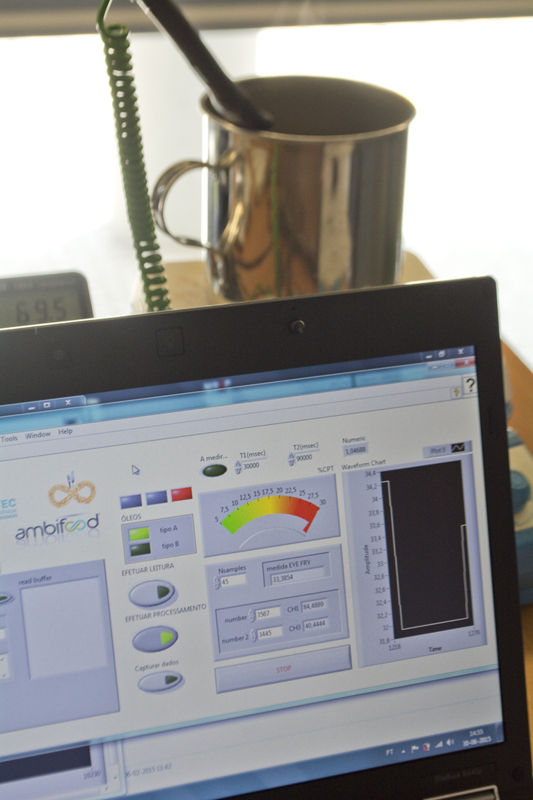INESC TEC develops technology that monitors frying oils using optical systems and smartphones
A unique technology in the world, made in Portugal, will make it possible to control the quality of frying oils using optical and software systems that register and monitor data through smartphones. The R&D project brought together INESC TEC, AMBIFOOD, the Faculty of Pharmacy of the University of Porto (FFUP) and ASAE’s Chemistry Lab.
03rd August 2015
Project EYEFRY develops unique technology in the world
A unique technology in the world, made in Portugal, will make it possible to control the quality of frying oils using optical and software systems that register and monitor data through smartphones. The R&D project brought together INESC TEC, AMBIFOOD, the Faculty of Pharmacy of the University of Porto (FFUP) and ASAE’s Chemistry Lab.


How did the EYEFRY originate?
The goal with the EYEFRY was to create an innovative system to control the degradation of food oils. This need was felt because of the legislation in force which states that only a maximum of 25% of polar composites can be found in frying oils, and because of the idea that the current analysis systems do not correspond to the needs of companies.
“The systems used today are not as robust and reliable, so we wanted to find a user-friendly, low-cost and reliable solution. In that sense, we wanted to enter an expanding market capable of creating jobs and to develop a product that we could internationalise”, states Artur Melo e Castro, CEO at AMBIFOOD. The project contemplates patent registry in various countries.
How does the technology developed by INESC TEC work?
EYEFRY contains a reading device that generates results and sends them to a smartphone which, in its turn, is connected to a general data control system with its own software.


This product was specifically designed for organisations working in the food industry, where quality control is mandatory, taking into consideration legal and economic issues.
Technology has an impact on economy and public health
Other than the economic benefits that the EYEFRY will bring, a causal relation has been found between the ingestion of frying oils, their degradation and the emergence of certain pathologies, such as degenerative illnesses, cancer, or early ageing.
“The solution developed as part of the EYEFRY provides an analysis system to food operators which not only preserves the health of consumers who will not be ingesting degraded oils, but also to avoid unnecessary costs, as the oils are properly controlled and their useful life is maintained within adequate levels”, states António Gaspar, coordinator of the Centre for Information Systems and Computer Graphics (CSIG) and project manager. INESC TEC’s Centre for Applied Photonics (CAP) has also participated in this project.


Results obtained presented at EYEFRY workshop on 30 June
On 30 June, INESC TEC hosted the final Workshop of project “EYEFRY”. The first speaker was Fernando Pichel, Director of the Nutrition and Food Service at the Porto Hospital Centre, with a presentation titled “Fat, amounts and quality – the implications for health.”
Afterwards, the Head of Division of ASAE’s (the Authority for Economic and Food Safety) Physics and Chemistry Lab, Maria da Graça Campos, spoke of “Polar Composites in Food Oils – framework and official control”.
Finally, Artur Melo e Castro explained the motivation for the design of EYEFRY and its practical interest.


The results of the project were presented by CSIG and CAP researchers, who first provided an overview of the work conducted at INESC TEC, and then presented the measurement equipment and the software used to acquire and process data. Lastly, the technology developed was demonstrated.
The INESC TEC team involved in the project is composed of: António Gaspar, Rui Barros, Luís Reis, Vasco Cardoso, Paulo Melo and Marta Pinto from CSIG, and Ireneu Dias, Carla Carmelo Rosa, Paulo Marques and Diogo Nogueira from CAP.
This project was funded by the Regional Operational Programme for the North of Portugal ("ON.2 - O Novo Norte"), of the National Strategic Reference Framework (NSRF), through the European Regional Development Fund (ERDF).
Photo credits 1: tumblr
The INESC TEC researchers mentioned in this article are associated with the following partner institutions: FCUP and INESC TEC.
INESC TEC, July 2015


